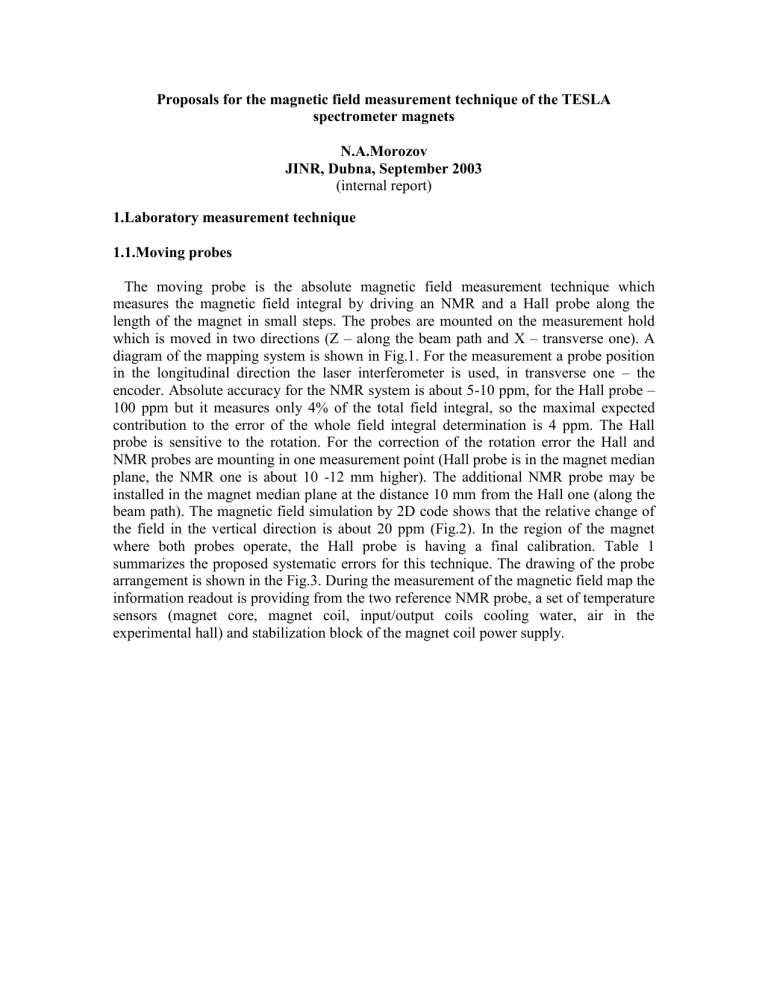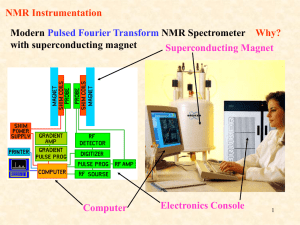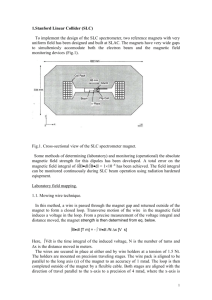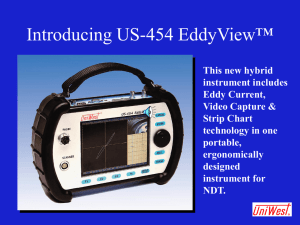Review of the magnetic measurement technique (experience of the

Proposals for the magnetic field measurement technique of the TESLA spectrometer magnets
N.A.Morozov
JINR, Dubna, September 2003
(internal report)
1.Laboratory measurement technique
1.1.Moving probes
The moving probe is the absolute magnetic field measurement technique which measures the magnetic field integral by driving an NMR and a Hall probe along the length of the magnet in small steps. The probes are mounted on the measurement hold which is moved in two directions (Z – along the beam path and X – transverse one). A diagram of the mapping system is shown in Fig.1. For the measurement a probe position in the longitudinal direction the laser interferometer is used, in transverse one – the encoder. Absolute accuracy for the NMR system is about 5-10 ppm, for the Hall probe –
100 ppm but it measures only 4% of the total field integral, so the maximal expected contribution to the error of the whole field integral determination is 4 ppm. The Hall probe is sensitive to the rotation. For the correction of the rotation error the Hall and
NMR probes are mounting in one measurement point (Hall probe is in the magnet median plane, the NMR one is about 10 -12 mm higher). The additional NMR probe may be installed in the magnet median plane at the distance 10 mm from the Hall one (along the beam path). The magnetic field simulation by 2D code shows that the relative change of the field in the vertical direction is about 20 ppm (Fig.2). In the region of the magnet where both probes operate, the Hall probe is having a final calibration. Table 1 summarizes the proposed systematic errors for this technique. The drawing of the probe arrangement is shown in the Fig.3. During the measurement of the magnetic field map the information readout is providing from the two reference NMR probe, a set of temperature sensors (magnet core, magnet coil, input/output coils cooling water, air in the experimental hall) and stabilization block of the magnet coil power supply.
Fig.1. Block diagram of the mapping system for the moving probe technique
Table 1. Systematic errors for the moving probe method
Error Source
Position determination (laser)
Error (ppm)
1
Misalignment of laser to beam path
NMR system
Hall probe precision (100ppm
4%)
Hall probe tilt (100ppm
4%)
Linear interpolation
Summary systematic error
0
5-10
4
4
10
24-29
40
30
20
10
0
0 5 10
Y(mm)
15 20
Fig.2. The relative maximal magnetic field change depending from the distance from the magnet median plane (B=0.44 T), (simulation by 2D POSSON SUPERFISH code)
Y
25
20
15
10
5 magnet pole
NMR
Hall magnet pole
35 mm
Z
0
0,0 0,5 1,0 1,5 2,0 2,5 3,0 3,5 4,0 4,5 5,0
Fig.3. Side view of the probes arrangement (Y – vertical direction)
25 pole axis
20
3000
+/- 1460
X mm
=5
10
15
+/- 1900
10
5
0
0,0 0,5 1,0 1,5 2,5 3,0 3,5 4,0 2,0
Z
Fig.4. The region of magnetic field measurement for the main spectrometer magnet
The geometrical parameters for the measurement bench and the tolerances required for it are presented in the Tab.2. The view of the measurement regions for the spectrometer main magnet is shown in the Fig.4. The region of common use for the Hall and NMR probes is marked by the grey color. For the estimation of the required step for the measurement regions (uniform and fringe) there were done calculations for changing of the magnet field integral from the step of integration. The results are presented in the
Fig.5. Initial value of the field integral was calculated with longitudunal step 2 mm.
Table 2. Geometrical data for the moving probe measurement bench
3800 mm
2920 mm
Step of measurement
10 mm
Longitudinal region (Z)
Region of common use Hall and NMR probes
Region of Hall probe use
Tolerance for measurement of probe Z position
Transverse region (X)
Tolerance for measurement of probe X position
Transverse position of the measurement region from the magnet pole axis
(
X mm
) / its possible adjustment
2*440 mm
1 ppm
10 mm
0.1 mm
5 mm/
5 mm
5 mm
1 mm
4
3
2
1
main part
fringe part
0
0 10 20
Z (mm)
30
Fig.5. Changing of the magnetic field integral from the step of integration in the main
(uniform field) part and in the fringe one
1.2. Search coils
The field integral measuring device uses the original method of two small coils connected in series and installed in magnet gap at the distance close to the magnetic length of the magnet. For this method only two parameters to be measured with the high accuracy of
10
-5
:
The distance between the magnetic centers of the two coils;
The central field for each measurement.
The first task has to be solved during the preliminary procedure of the coils calibration, the second one by NMR probes with accuracy better then 5 ppm. A diagram of the mapping system is shown in Fig.5. The principal scheme is closed to the one used for moving probe technique (Fig.1). Instead of the Hall Teslameter the integrator with search coils is used. The new mechanical holder for the coils has to be developed. The measurement procedure consists from the moving of the probes for the time of a few seconds to a distance of 3.01 m. The control by the longitudinal and transverse motion, the readout of other magnet parameters is realizing by the same way as for moving probes method. For the magnet field reference two fixed NMR probes are used, the third one – for the readout the central magnet field. Table 2 summarizes the proposed systematic errors for this technique.
Table 2. Systematic errors for the search coils method
Error Source Error (ppm)
Position determination (laser)
NMR probe
Distance between coils axis
Integration of the coils output signal (100 ppm * 1%)
Summary systematic error
1
5 -10
7
1
14-19
Fig.5. Block diagram for the search coil technique
1.3. Additional experiments for the spectrometer magnets measurements
A lot of preliminary calibration work will be required:
calibration of the Hall probes (periodical recalibration);
calibration of the search coils.
During the measurement stand commissioning it has to be done:
testing of the mechanical equipment (tolerances);
testing of the laser interferometer;
probes (NMR, Hall, coils) positioning and alignment.
As it is rather difficult to provide magnetic measurements inside the vacuum chamber
(diameter 20 mm) a lot of special measurements has to be provided for investigation of it’s influence. Some experiments has to be done for determination of the magnetic effect from the special screens in the end points of the spectrometer magnet.
2. Test and working measurement technique
After the finishing of the laboratory spectrometer magnetic field measurements procedure, the main magnet moves and installs to its working place at the TESLA beam line. For the final test magnetic measurements it is proposed to use the moving probes technique (NMR + Hall probe) by help of the specially desined probe holder realizing the measurement procedure inside the beam vacuum chamber. During this test measurements the final calibration is realizing for the reference NMR probes and the moving wire probe. After the finishing of this round of the magnetic field measurements the TESLA beam working spectrometer field indegral estimation is providing by NMR reference probes and the moving wire probe. The probes arrangement is shown in the Fig.6.
25
Y magnet pole reference NMR vacuum chamber
15
20 magnetic screen
Hall NMR
19 mm
Z
10 probes holder
5 moving wire holder
0
0,0 0,5 1,0 1,5 light from laser interferometer
2,0 2,5 3,0 3,5 4,0
Fig.6. Side view of the probes arrangement (Y – vertical direction) for the test and working measurement technique







